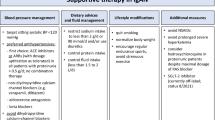Abstract
Background
To elucidate the pathologic significance of double-contour lesions of glomerular capillary walls, we determined how the clinical course of patients with diffuse and global double-contour lesions differs from that of patients with segmentally located double-contour lesions.
Methods
In 26 out of 308 cases of idiopathic glomerulonephritis double contour lesions and serum complement 3 (C3) deposition along capillary walls were histologically examined.
Results
Most patients with diffuse (affecting more than 80% of all glomeruli) and global (affecting more than 75% of each glomerulus) double-contour lesions exhibited a persistent profound proteinuria and a deterioration of renal function (assessed via serum creatinine measurements) during a mean observation period of 66 months, even when a transient remission was observed. The amelioration of hypocomplementemia correlated significantly with an improvement in proteinuria (P<0.05). A follow-up biopsy of patients revealed some cases in which there was: (1) no amelioration of the glomerular lesion despite improvements in renal function, proteinuria and hypocomplementemia; (2) an amelioration of the glomerular lesion paralleling an increasing stability in renal function and a reduction in proteinuria; or (3) deterioration of the glomerular lesion paralleling a decrease in renal function, an increase in proteinuria, and persistent hypocomplementemia.
Conclusions
These findings indicate that the clinical characteristics of mesangiocapillary glomerulonephritis differ from those of other types of mesangial proliferative glomerulonephritis with segmentally-located double-contour lesions. A spot, unrepeated biopsy in cases of atypical mild mesangiocapillary lesions provides insufficient information to reach a diagnosis of mesangiocapillary glomerulonephritis.
Similar content being viewed by others
References
Churg J, Sobin LH. Mesangiocapillary glomerulonephritis. In: Renal disease, classification and atlas of glomerular disease. Tokyo: Igaku-shoin, 1982:83–84.
Strife CF, McAdams AJ, West CD. Membrano-proliferative glomerulonephritis characterized by focal, segmental proliferative lesions. Clin Nephrol 1982;18:9–16.
Cameron JS, Truner DR, Heaton F, Williams DG, Ogg CS, Haycock GB, Hicks J. Idiopathic mesngiocapillary glomerulonephritis: Comparison of type 1 and type 2 in children and adults and long-term prognosis. Am J Med 1983;74:175–192.
Glassock RJ, Adler SG, Ward HJ, Cohen AH. Primary glomerular disease. In: Brenner BM, Rector FC Jr (eds) The Kidney. 4th ed. Philadelphia: WB Saunders, 1991:1182.
Fye KH, Hancock D, Moutsopoulous H, Humes HD, Arieff AI. Low-dosage heparin in rapidly progressive glomerulonephritis. Arch Intern Med 1976:136:995–999.
Cameron JS, Glasgow EF, White RHR. Membranoproliferative glomerulonephritis and persistent hypocomplementemia. Br Med J 1970;4:7–14.
Kincaid-Smith P. The treatment of chronic mesangiocapillary (membranoproliferative) glomerulonephritis with impaired renal function. Med J Aust 1972;2:587–592.
Zimmerman SW, Moorthy AV, Dreher WH, Friedman A, Varanasi U. Prospective trial of warfarin and dipyridamole in patients with membranoproliferative glomerulonephritis. Am J Med 1983;75:920–927.
Donadio JV, Anderson CF, Mitchell JC, Holley KE, Ilstrup DM, Fuster V, Chesebro JH. Membrano-proliferative glomerulonephritis. A prospective clinical trial of platelet-inhibitor therapy. N Engl J Med 1984;310:1421–1246.
McEnery PJ, McAdams AJ, West CD. Membrano-proliferative glomerulonephritis: improved survival with alternate day prednisone therapy. Clin Nephrol 1980;13:117–124.
Watanabe T, Hattori F, Tanaka K. Experimental study on the origin of glomerular foam cells in glomerulonephritis. Jpn J Nephrol 1980;22:163–174.
Hyman LR, Burkholder PM. Focal sclerosing glomerulonephritis with segmental hyalinosis. A clinicopathological analysis. Lab Invest 1973;28:533–544.
Burkholder PM, Hyman LR, Krueger RP. Characterization of mixed membranous and proliferative glomerulonephritis. In: Kincaid-Smith P, Mathew TH, Becher EL (eds), Glomrulonephritis: morphology, natural history and treatment. New York: John Wiley and Sons, 1973:557–589.
Belgiojosso G, Tarantino A, Colasanti G, Bazzi C, Guerra L, Durante A. The prognostic value of some clinical and histological parameters in membrano-proliferative glomerulonephritis. Nephron 1977;19:250–258.
Swainson CP, Robson JS, Thomson, D, MacDonald MK. Mesangiocapillary glomerulonephritis: a long term study of 40 cases. J Pathology 1983;141:449–468.
Bohle A, Gertner HV, Fischbach H, Bock KD, Edel HH, Frotscher U, Kruthe R, Monninghoff W, Scheler F. The morphological and clinical features of membrano-proliferative glomerulonephritis in adults. Virchows Arch [Pathol Anat] 1974;363:213–224.
Shigematsu H, Kobayashi Y, Tateno S, Hiki Y, Kawano S. Ultrastructural glomerular loop abnormalities in IgA nephritis. Nephron, 1982;30:1–7.
Strife CF, McEnery PT, McAdams AJ, West CD. Membranoproliferative glomerulonephritis with disruption of the glomerular basement membrane. Clin Nephrol 1977;7:65–72.
Author information
Authors and Affiliations
About this article
Cite this article
Kobayashi, S., Hishida, A. & Nagase, M. Clinicopathologic study of glomerulonephritis showing double-contour lesions. Clin Exper Neph 1, 121–130 (1997). https://doi.org/10.1007/BF02479911
Received:
Revised:
Accepted:
Issue Date:
DOI: https://doi.org/10.1007/BF02479911




